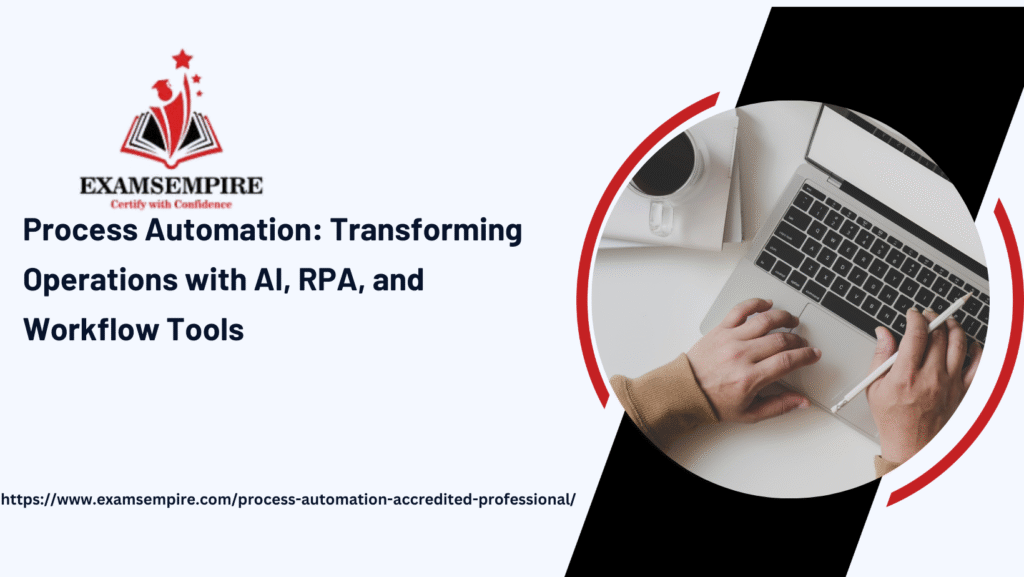In today’s fast-paced digital economy, organizations are under constant pressure to deliver faster, reduce costs, and improve accuracy. Manual, repetitive tasks not only slow down productivity but also increase the risk of human errors. This is where process automation comes in.
Process automation refers to the use of technology—such as robotic process automation (RPA), artificial intelligence (AI), machine learning (ML), and workflow automation tools—to streamline business processes and reduce reliance on manual labor. From banking and healthcare to manufacturing and IT, process automation is transforming industries by enabling organizations to operate smarter and faster.
What is Process Automation?
Process Automation is the practice of automating business processes using software, robotics, or digital tools to handle tasks traditionally done by humans. The goal is to improve efficiency, reduce costs, and enhance scalability.
Examples include:
- Automating invoice approvals in finance.
- Chatbots answering customer service queries.
- HR systems automating employee onboarding.
- Manufacturing robots assembling products on production lines.
Types of Process Automation
1. Robotic Process Automation (RPA)
RPA uses software robots (bots) to perform repetitive tasks like data entry, form filling, and report generation.
2. Intelligent Process Automation (IPA)
IPA combines RPA with AI and ML to handle more complex processes such as fraud detection or predictive customer support.
3. Business Process Automation (BPA)
BPA automates end-to-end workflows like procurement, payroll, or supply chain management.
4. IT Process Automation (ITPA)
Focuses on automating IT operations such as server monitoring, log analysis, and incident response.

Key Benefits of Process Automation
1. Increased Efficiency
Automation speeds up tasks, reduces delays, and eliminates bottlenecks.
2. Cost Reduction
By minimizing manual labor, organizations save money and reduce operational overhead.
3. Improved Accuracy
Automated processes are less prone to human errors, ensuring compliance and data integrity.
4. Scalability
Automation allows businesses to scale operations without increasing workforce size.
5. Enhanced Employee Productivity
Employees can focus on strategic and creative tasks instead of repetitive, low-value activities.
6. Customer Satisfaction
Faster response times and consistent service improve customer experiences.
Tools and Technologies Driving Process Automation
- Robotic Process Automation Tools: UiPath, Automation Anywhere, Blue Prism.
- Workflow Automation Platforms: Zapier, Nintex, Kissflow.
- AI & Machine Learning Platforms: IBM Watson, Google AI, Microsoft Azure AI.
- Cloud-based Automation: AWS Lambda, Google Cloud Functions, Azure Automation.
- Business Process Management Suites (BPMS): Appian, Pega, Oracle BPM.
These tools make it easier for businesses to integrate automation into existing systems.
For more information visit us
https://www.examsempire.com/process-automation-accredited-professional
Steps to Implement Process Automation Successfully
- Identify Automation Opportunities
Start by analyzing business workflows and identifying repetitive, time-consuming, and error-prone tasks. - Define Goals and KPIs
Set measurable goals like reducing processing time by 40% or lowering operational costs by 20%. - Choose the Right Tools
Select automation platforms that align with business needs and IT infrastructure. - Develop a Pilot Project
Begin with small-scale automation to test feasibility before rolling it out across the organization. - Employee Training
Prepare employees for new roles and ensure they understand how automation will enhance their work. - Monitor and Optimize
Track performance metrics and continuously refine automation workflows.
Challenges of Process Automation
While process automation has many benefits, it also comes with challenges:
- High Initial Costs: Implementing advanced automation tools can be expensive.
- Resistance to Change: Employees may fear job loss or struggle to adapt.
- Integration Issues: Automation tools may not seamlessly integrate with legacy systems.
- Security Concerns: Automated processes handling sensitive data must comply with security standards.
- Maintenance Needs: Automated systems require regular updates and monitoring.
Future of Process Automation in 2025 and Beyond
Process automation is evolving rapidly, and the future will be shaped by:
- Hyperautomation: Combining RPA, AI, and analytics to automate end-to-end business processes.
- AI-Powered Decision Making: Using predictive analytics for real-time business decisions.
- No-Code/Low-Code Platforms: Allowing non-technical staff to build automation workflows.
- Cloud-First Automation: Expanding automation through cloud-native services.
- Human + Machine Collaboration: Employees working alongside intelligent bots for higher efficiency.
As organizations push for digital transformation, automation will no longer be optional—it will be a core business strategy.
Process automation is a game-changing strategy that empowers organizations to reduce costs, improve efficiency, and scale operations with ease. By leveraging RPA, AI, and workflow tools, businesses can transform repetitive manual tasks into streamlined automated workflows.
While challenges such as cost, integration, and resistance to change exist, the long-term benefits—improved accuracy, scalability, and productivity—far outweigh the hurdles.
In 2025 and beyond, process automation pdf dumps will continue to evolve, moving towards hyperautomation, AI-driven decision-making, and low-code platforms that make automation accessible to all businesses. Organizations that embrace automation early will not only gain a competitive edge but also future-proof their operations in the digital era.

